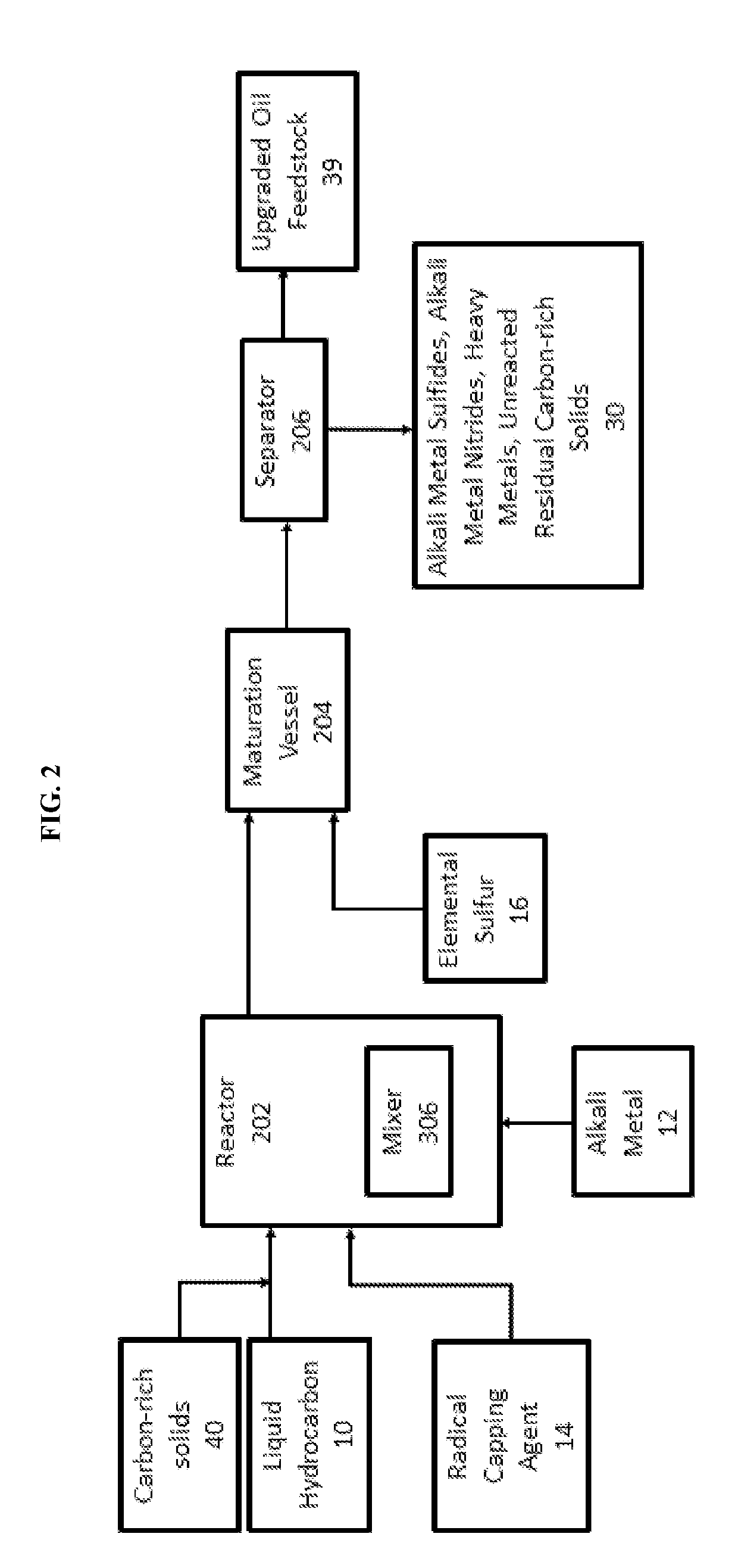Process for separating particles containing alkali metal salts from liquid hydrocarbons
a technology of liquid hydrocarbons and metal salts, which is applied in the field of process for separating particles containing alkali metal salts from liquid hydrocarbons, can solve the problems of affecting the use of hydrocarbons, affecting the quality of hydrocarbon oil, and removing sulfur
- Summary
- Abstract
- Description
- Claims
- Application Information
AI Technical Summary
Benefits of technology
Problems solved by technology
Method used
Image
Examples
example 1
zation with Sodium Followed by Sulfur Treatment and Solids Separation
[0051]A vacuum residuum oil feedstock was treated with sodium metal in a pilot plant using a continuous system essentially as shown in FIG. 1 under the following conditions to yield a mixture of treated oil and fine particles comprising sodium sulfide.
Oil Feed Rate: 66 kg / h
Sodium Feed Rate: 2.1 kg / h
Hydrogen Feed Rate: 250 g / h
Reaction Temperature: 352° C.
Reaction Pressure: 1425 psi
[0052]Aliquots of the mixture of oil and fine particles were mixed with elemental sulfur under the following batch conditions (Table 1). The amount of sulfur remaining in the oil was measured.
[0053]
TABLE 1HoldOil AddedSulfurTemperaturePressureTimeWt %Trial(g)Added (g)(° C.)(psi)(min)Sulfur1A200.30.678350300-350600.171B199.92.861350300-350600.181C2005.06350300-350600.211D200.18.371350300-350600.54
example 2
s Desulfurization with Sodium Followed by Continuous Sulfur Treatment and Solids Separation
[0054]A vacuum residuum oil feedstock was treated with sodium metal in a pilot plant using a continuous system essentially as shown in FIG. 1 under the following four trial conditions to yield a mixture of treated oil and fine particles comprising sodium sulfide.
[0055]
TABLE 2OilHydrogenfeed rateSodium feedfeedReactionReaction PTrial(kg / h)rate (g / min)rate (g / h)Temp. (deg C.)(psi)2A65.8352503787502B65.8362503787502C65.7352503507502D65.935279358750
[0056]Trials 2A-2D provided four mixtures of sodium-reacted oil feedstock and particles containing sodium sulfide that were processed in a continuous fashion at a pilot plant using the present separation process in accordance with FIG. 1 and the conditions of Trials 3A to 3D shown below in Table 3. The amount of sulfur was measured in the desulfurized liquid hydrocarbons.
[0057]
TABLE 3Sulfur FeedRateTemperaturePressureHold TimeWt %Conditions(g / min)(° C.)...
example 3
f Residual Sodium from Desulfurized Liquid Hydrocarbons
[0058]After desulfurization and separation of solids in accordance with the procedure of Example 2, the desulfurized liquid hydrocarbons were treated with a mixture of acetic acid and sodium acetate in accordance with the process of FIG. 1 and under the conditions shown below in Table 4.
[0059]
TABLE 4InitialFinal[Na]AceticTemperatureTime[Na]Trials*(ppm)Acid / Na ratio(° C.)(min)(ppm)4A (Batch)15001.035030724B5302.332355824C5306.43135724D5306.42455644E5306.42675511*Continuous conditions except as indicated
PUM
| Property | Measurement | Unit |
|---|---|---|
| temperature | aaaaa | aaaaa |
| temperature | aaaaa | aaaaa |
| pressure | aaaaa | aaaaa |
Abstract
Description
Claims
Application Information
 Login to View More
Login to View More - R&D
- Intellectual Property
- Life Sciences
- Materials
- Tech Scout
- Unparalleled Data Quality
- Higher Quality Content
- 60% Fewer Hallucinations
Browse by: Latest US Patents, China's latest patents, Technical Efficacy Thesaurus, Application Domain, Technology Topic, Popular Technical Reports.
© 2025 PatSnap. All rights reserved.Legal|Privacy policy|Modern Slavery Act Transparency Statement|Sitemap|About US| Contact US: help@patsnap.com


